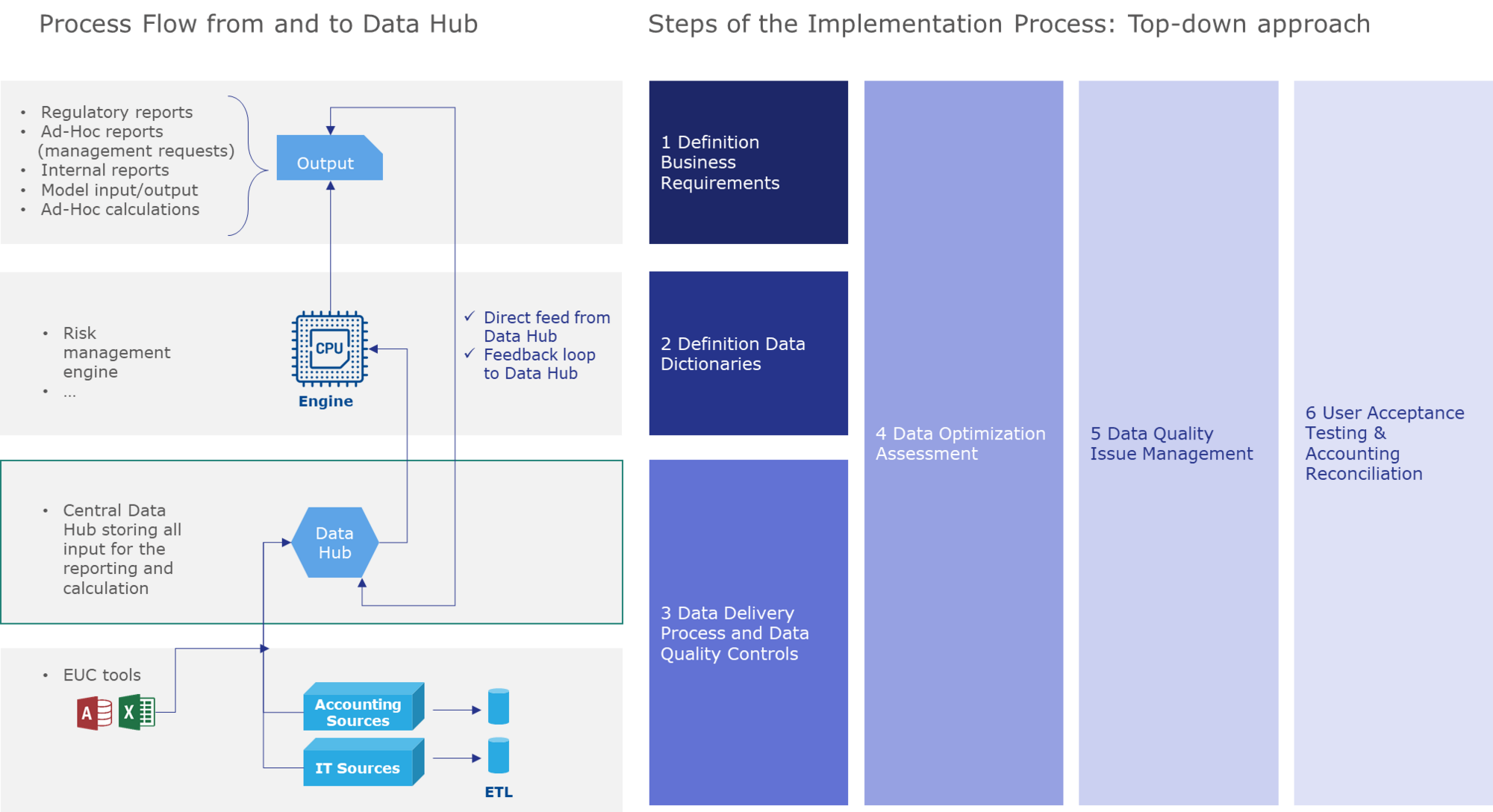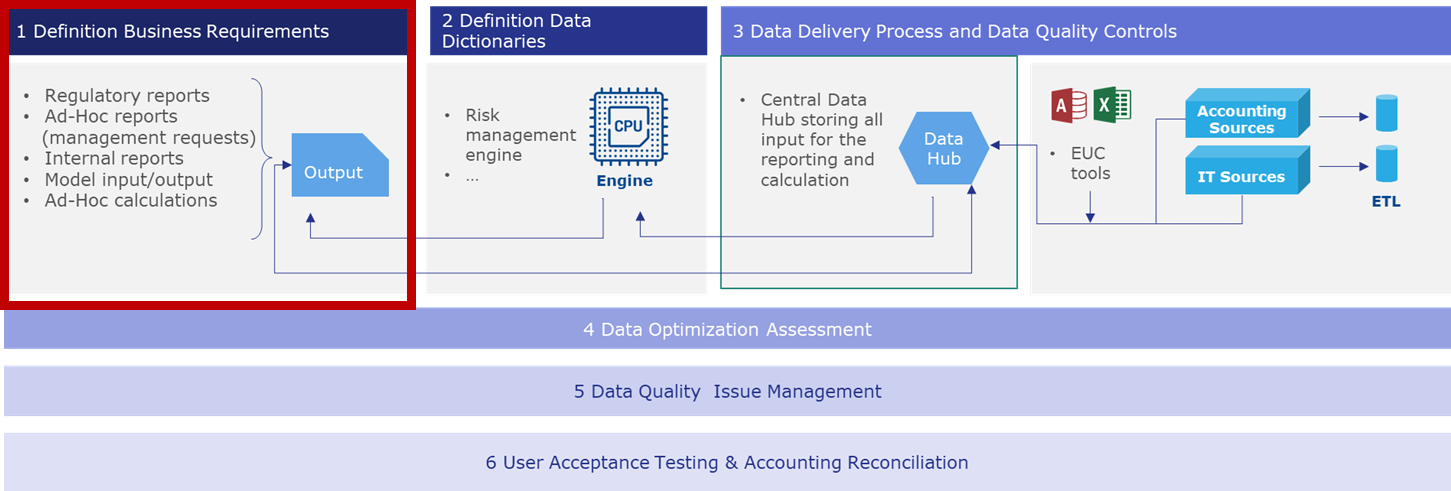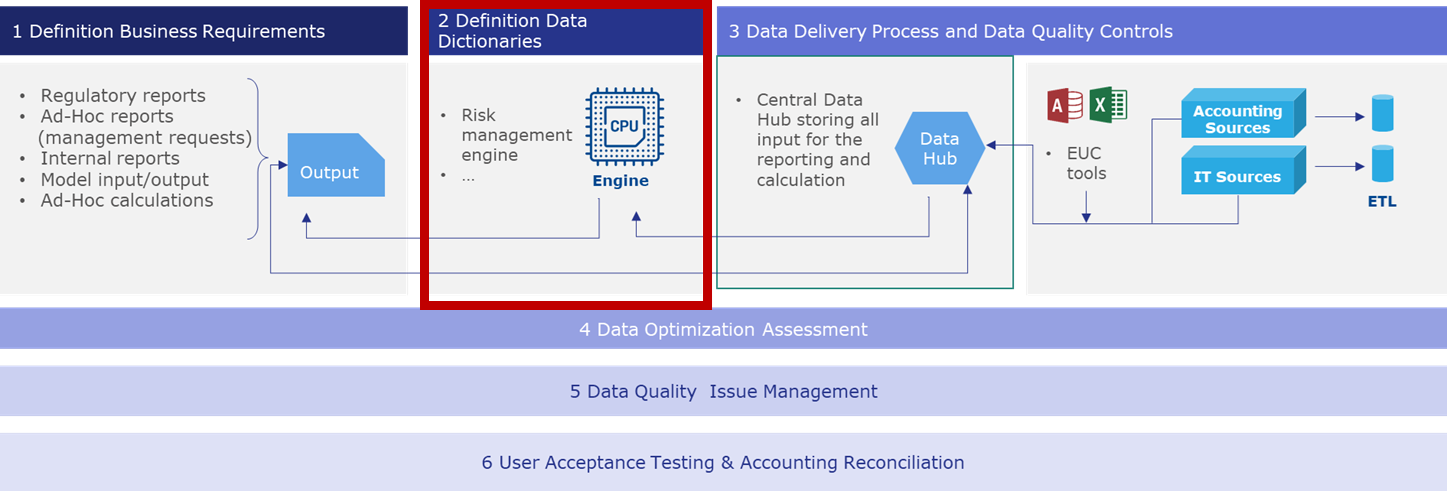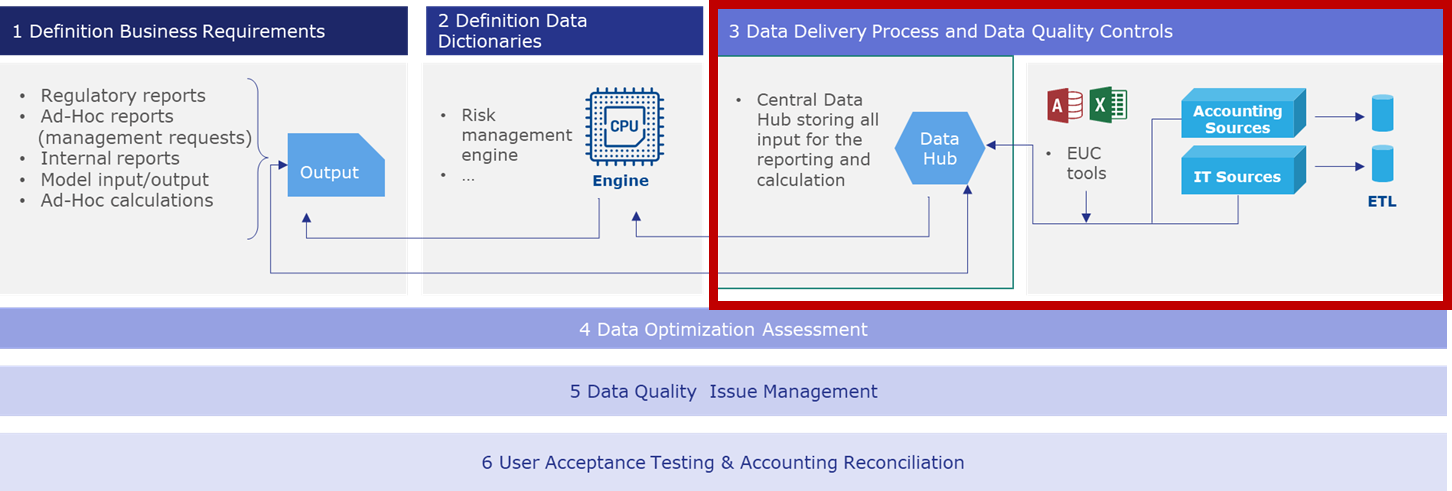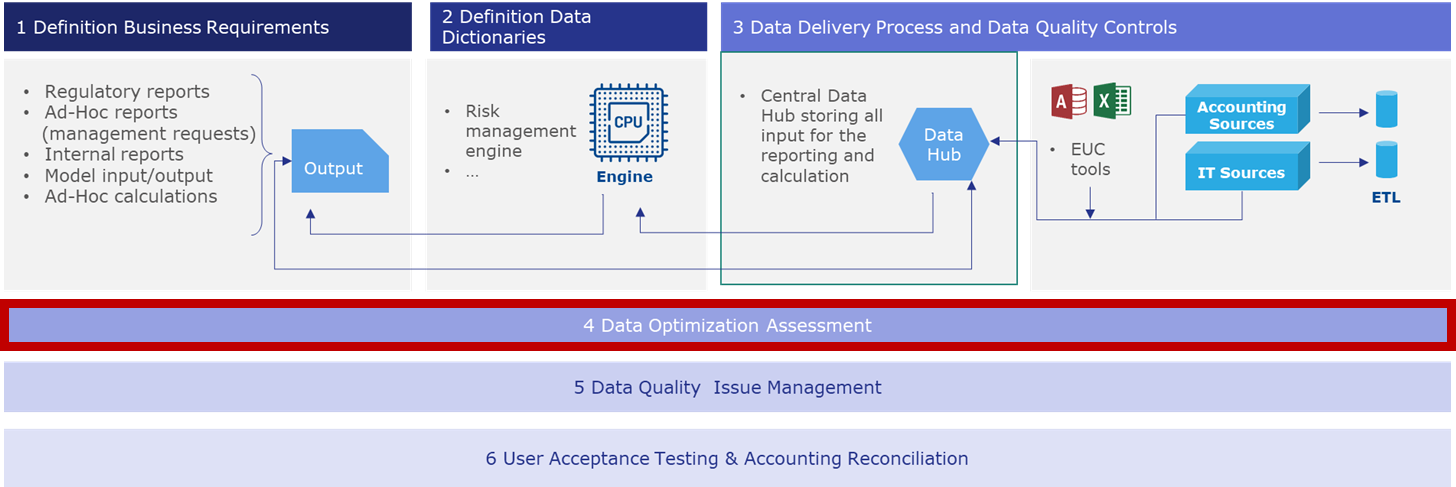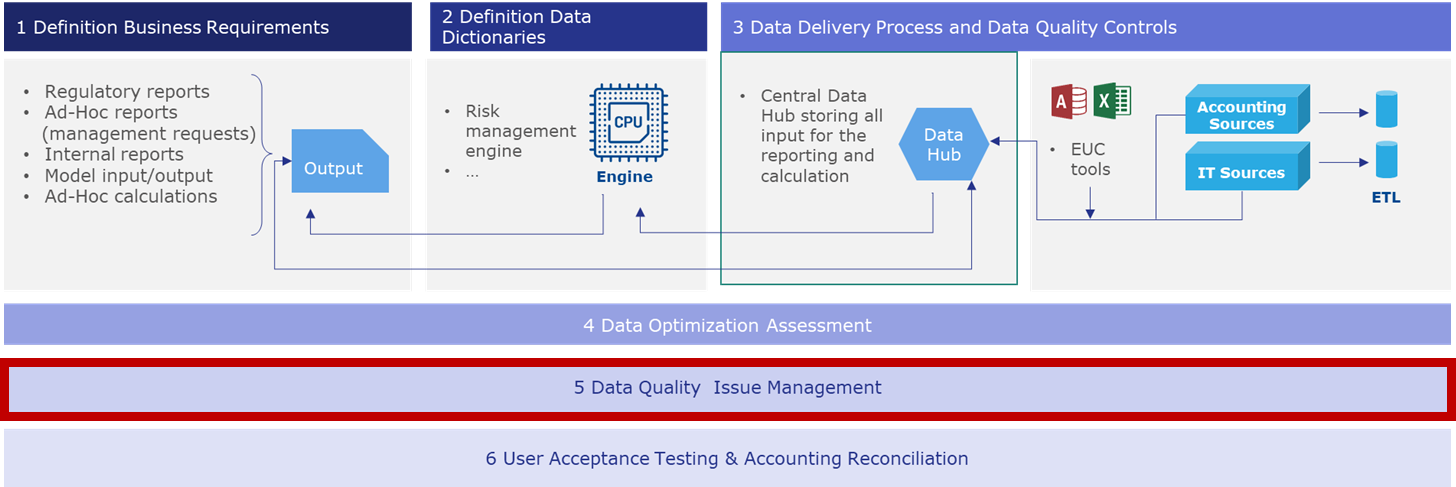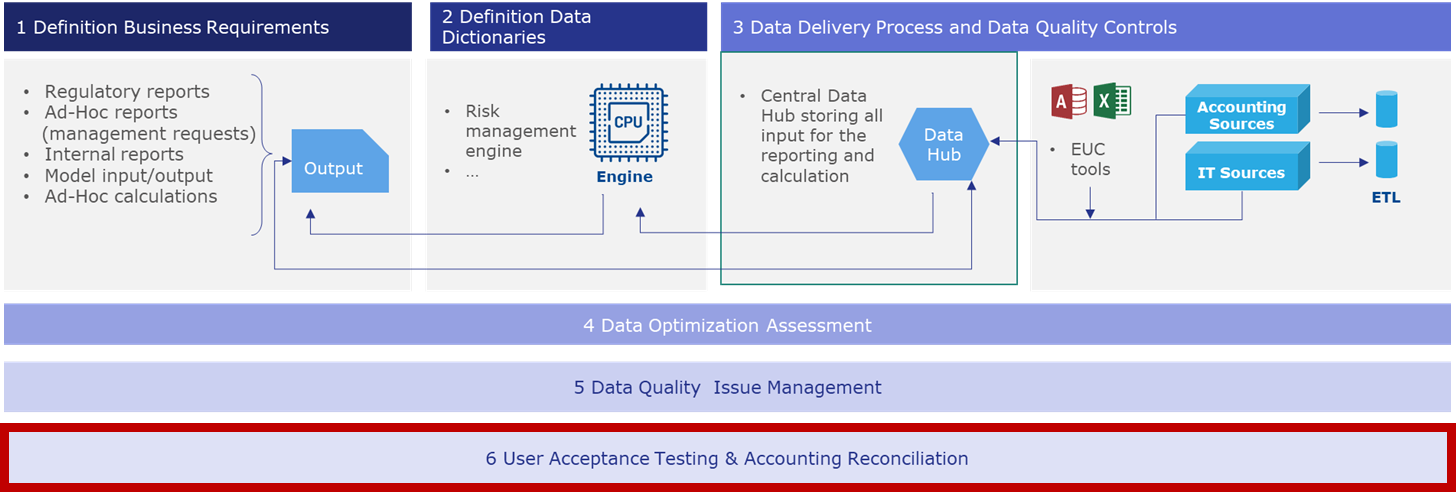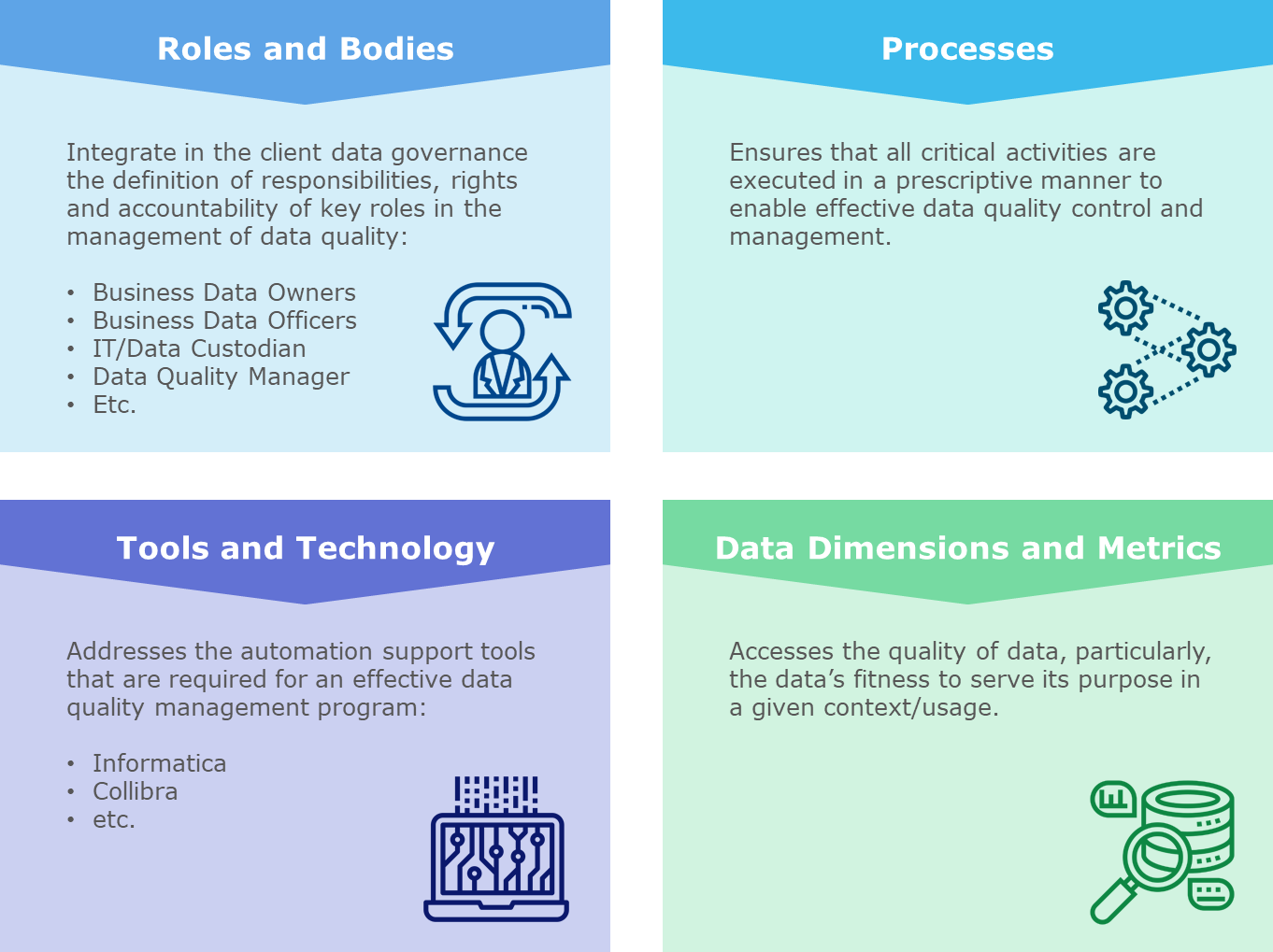Written by Thomas Gillet, Partner Embex,
and Kristian Lajkep, Regulatory Compliance Officer
General context
On January 2013, the Basel Committee on Banking Supervision has issued a set of principles, so-called BCBS 239, for banks to comply with in terms of their Governance, IT infrastructure, Data aggregation capabilities and Risk reporting practices.
In this paper, whose summary you can find here, the Basel Committee has introduced qualitative expectations for risk reporting organisation, processes and tools and quantitative expectations for reporting. These requirements display an increased focus on data quality, as well as emphasis on risk aggregation, timeliness, accuracy, comprehensiveness and granularity when producing a report. It should be quite clear that following these principles duly is an undertaking that requires tremendous technical and technological sophistication as regards tools, IT infrastructure and computational power. These are apparently difficult to obtain, but not to most financial institutions. The key problem, as we observe, is going about using those tools for a BCBS 239 project.
Most of our clients have launched complex initiatives to set up framework ensuring long-term adhesion to the BCBS 239 Principles, by embedding them into their daily behaviour and risk data and reporting-related practices.
Undertaking such project requires solid experience in managing projects which include several entities (in case the bank is part of a larger group), departments and stakeholders. Indeed, the main apparent challenge of these type of projects is that they are essentially transversal between a number of departments (Risk, Finance & IT). To cope with this, some banks have put in place a so-called Data Office, which takes charge of all data management & data governance initiatives across the bank.
To drive and support BCBS 239 projects, an adequate project management approach enabling a smooth and structured implementation is paramount. It is also crucial to ensure good communication between all the stakeholders and the BCBS 239 project team (whether or not the team is located within the data office department).
Our Approach
Most of enterprises would wish to start their BCBS 239 with the creation of a unified Risk & Finance data warehouse which consolidates and centralised data from different source systems in order to create a reliable single source of information (Data Hub). And here already comes the first stumbling block which needs to be avoided. Building a Risk & Finance Data Hub takes years. We have seen many projects that were in jeopardy or even came to a screeching halt because of lack of concrete delivery (no or little added value for Risk – usually sponsor of the project). Therefore, opting for a piecemeal and iterative, rather than enterprise-wide implementation is crucial, not least in order to be able to answer a not at all unreasonable question of all stake holders: “What are we really getting out of this?”
Iterations
Although a multitude of different risk reports exists, they all are made with either of two purposes: they are either for risk managers, giving them insight on what is going on within the business – In which case cherry picking the most important information is essential, or they are for regulators or other stake-holders, in which case completeness and compliance with existing rules/standards are the main concern. An iteration consists of rolling out the entire cycle for a subset of reports.
Consequently, Finalyse proposes a top-down approach (starting with the analysis of the reports) that clearly highlights the dependencies between Risk, IT and the Data Offices during the project lifecycle, through a list of clearly identified deliverables that should be produced for each iteration.
Explaining the process:
We understand that the scheme above, whilst complete and not complicated, requires some explanation. This section details the respective steps that need to be taken for each iteration.
Definition of the business requirements:
The Business requirements are the final needs of the business users to perform their tasks. These requirements are not limited to a set of data, they are the comprehensive set of all the information on the final outcomes of all the previous reporting or calculations, e.g.:
- Regulatory Reports and calculations
- Ad-Hoc reports and calculations
- Internal reports: P&L dashboard
The business requirements also represent the ambition level from a business perspective:
- Audit open points that can be solved through their definition in the requirements
- Additional features to add in a specific report or calculation outcome
- Correction Module to correct the data without passing through the entire delivery process
- Storage Capacity definition of historical data to be stored in the system for the output production
Definition of the Data Dictionaries
The Data Dictionary is a set of files gathering all the input data necessary for the production of the business requirements following a specific layout:
- formal name of the data
- business description in terms of content
- list of values that are accepted
- data convention format
- Priority of the attribute
- data owner
- Data quality controls to apply to the attribute
The Data Dictionaries are the baseline for the creation of the Data Model. They provide a clear view on data via definition and thus are a great way to clean-up the redundant data. The document serves as an exhaustive list of the required data. When an issue arises on data, the user can directly escalate the problem to the responsible department.
Definition of the Data Delivery documentation
The Data Delivery Process represents the translation of the raw input data, stored in the IT sources, into their refined version translated into the Data Hub. This document provides a high-level overview of the process flow, identifying the main IT sources, players, and data flows from the back-end applications to Data Hub.
In the dataflow between two sources there might also be:
- Data transformations
- Data enrichments
The Data Mappings must define the relationship between the attributes in the source applications and their translation into the Data Hub. The idea of the Data Mapping is to be able to follow every single attribute from the Data Hub back to its original source.
Data Dashboard
The Data Dashboard provides on overview of the quality of the data stored in the Data Hub at an aggregated level. The requirements for the Dashboard should be defined by the business who will be ultimately responsible for the sign-off of the reports produced based on the Data Hub.
Quality of the official report
The final Data Quality overview should be at report level. This overview will provide an overall judgement of the inner quality of the data and maturity of the report, within the DQ framework in place.
Data Optimization Assessment as a complete valuation of the underlying processes
The business and IT personnel should assess the opportunity to optimize some of the underlying processes. Their assessment would contribute to an updated version of the Data Delivery. The Data Optimization typically consists of a file that sets, by schemes and descriptions, the content of the data workflows optimized for each department and for a specific business event.
Data Quality Issue Management
The Data Quality Issue Management is a continuous process involving different responsible persons from the departments involved in the entire process to identify and resolve the data quality issues.
User Acceptance Testing and Accounting Reconciliation
The user acceptance testing activities should be performed only during the testing phase of the implementation and discarded once validated the shift towards Data Hub.
Together with the Data Analyst, the business should help to create a set of unique and consistent metrics representing the quality of the data in Data Hub against the one in the reference dataset.
Once defined, the actors should define for each metric a threshold. When the data are loaded in Data Hub there might be two scenarios:
- Differences above the threshold: The Data Analyst will start an investigation on the data flow between the source IT systems and the feed to Data Hub (through the Data Delivery and Data Mappings documents)
- Differences below the threshold: The good quality of the data in Data Hub will trigger the action of the business to produce those output that can be created with satisfactory metrics
Once those metrics are satisfactory, the business can perform the core activity of UAT by comparing the newly created output against the ones produced with the reference dataset. Either:
- The output is fully comparable: This is the optimal outcome; the output from Data Hub is fully consistent with the reference one and can be sign off. From a Data Analyst perspective, the Data Delivery and Data Mappings are aligned with the previous architecture.
- The output is not consistent: The business should trigger the action of the Data Analyst for the resolution of the identified defect. The Data Analyst, once verified and resolved the defect, will create a new Data Hub delivery, and trigger the business for the creation of a new output.
The last step is the reconciliation of the Data Hub output with the Accounting figures
- For the accounting reconciliation, the Data Analyst, in cooperation with the business who sets the requirements, will build a Reconciliation Report
- The Reconciliation Report should be built for the running mode and produced regularly based on the requirements set out by the business
- The direct feed into Data Hub of the Accounting figures from the accounting system (the “Single Source of Truth”) will guarantee the validity and consistency of the reconciliation report each time it needs to be run
The Four Pillars:
Everything described above refers to the formation of a plan – process routes, descriptions etc. Next step is implementing these plans within the company tools, processes, metrics, and roles/bodies.
Based on our past experience on similar projects, we consider the tight involvement of business to be paramount to the success of the project and expect that at least the following items are delivered by the business representatives (Risk and/or Finance department) to ensure a smooth and viable collaboration with Data Office and the IT teams which are in charge of the development. It is crucial that these are indeed delivered by the business and not outsourced.
The Data Quality Operating Model, switching the gears to the qualitive aspect, is usually organized into four core components that cover people, processes, data, and technology to enable a consistent understanding and implementation of Data Quality capabilities. The Data Hub that is embedded in a broader solution that tackles not only the need in terms of data gathering and data storage but also Metadata, Data Lineage, Data Quality & Data Distribution.
On past projects we observed several pitfalls to avoid, best practices to be put in place and questions to be answered as follows:
- Data Quality Operating Model: Implementation of the data quality operating model is challenging. Roles and Bodies require clarifications. Processes to investigate unavoidable data quality issues need to be foreseen, budgeted and implemented.
- Data Hub: The primary focus should be on the data gathering and reconciliation with accounting. In a first stage we usually advise putting on hold pieces of the operating model (Roles & Bodies, Processes) and to focussing first on data file level for the Data Dimension and Metrics (quality check at aggregate level).
- Data Office: should share its vision and detail the expected benefits that it can provide for the other departments. During that roadshow, the involvement of each department should be planned and budgeted.
- Change management related to the proposed Data Quality Operating Model is paramount. The role of the Data Office in the running mode needs to be clarified as well: should the data office be responsible for the set-u p of the tools & processes to cover data management/data governance only? What about the data gathering & data storage part? Should it be transferred to IT or an external provider once the project is delivered? Before completing the IT architecture, Data Office should also tackle the Finance/Risk Data Hub related data flows, it should develop the accounting reconciliation and test dashboard & data dashboard (both at aggregated level).
Conclusion
It has been noted by our experts that implementing BCBS 239, more so than some other projects, does not require a particularly high level of technical brilliance or sophisticated modelling. However, that does not mean, that the BCBS 239 projects are easy or do not require any sophisticated tools. It is just that the people and plans prove to be much bigger obstacles then the tools. First there is an overall vision – a “big bang” implementation will see the institution run out of patience and a good will well before the project is close to bearing any fruit. An iterative approach is essential. Secondly, when conducting the project, all the departments concerned (and there is a good number of them) must be clear on when they are expected to participate in and how. Typically, a vague instruction mean that most people ignore the necessary actions, with hopes and (often quire sincere) expectations, that somebody else will provide them. On the side of our consultants, getting all of our clients’ departments to seamlessly cooperate and follow one vision may be the most difficult part of this type of project.
Thus, rather than technical skill such projects require a giant portion of common sense coupled with a heathy dose of experience and an ability to manage expectations and to communicate. Both on the side of us as consultants and on the side of our clients.
Finalyse InsuranceFinalyse offers specialized consulting for insurance and pension sectors, focusing on risk management, actuarial modeling, and regulatory compliance. Their services include Solvency II support, IFRS 17 implementation, and climate risk assessments, ensuring robust frameworks and regulatory alignment for institutions. |

Our Insurance Services
Check out Finalyse Insurance services list that could help your business.
Our Insurance Leaders
Get to know the people behind our services, feel free to ask them any questions.
Client Cases
Read Finalyse client cases regarding our insurance service offer.
Insurance blog articles
Read Finalyse blog articles regarding our insurance service offer.
Trending Services
BMA Regulations
Designed to meet regulatory and strategic requirements of the Actuarial and Risk department
Solvency II
Designed to meet regulatory and strategic requirements of the Actuarial and Risk department.
Outsourced Function Services
Designed to provide cost-efficient and independent assurance to insurance and reinsurance undertakings
Finalyse BankingFinalyse leverages 35+ years of banking expertise to guide you through regulatory challenges with tailored risk solutions. |

Trending Services
AI Fairness Assessment
Designed to help your Risk Management (Validation/AI Team) department in complying with EU AI Act regulatory requirements
CRR3 Validation Toolkit
A tool for banks to validate the implementation of RWA calculations and be better prepared for CRR3 in 2025
FRTB
In 2025, FRTB will become the European norm for Pillar I market risk. Enhanced reporting requirements will also kick in at the start of the year. Are you on track?
Finalyse ValuationValuing complex products is both costly and demanding, requiring quality data, advanced models, and expert support. Finalyse Valuation Services are tailored to client needs, ensuring transparency and ongoing collaboration. Our experts analyse and reconcile counterparty prices to explain and document any differences. |

Trending Services
Independent valuation of OTC and structured products
Helping clients to reconcile price disputes
Value at Risk (VaR) Calculation Service
Save time reviewing the reports instead of producing them yourself
EMIR and SFTR Reporting Services
Helping institutions to cope with reporting-related requirements
Finalyse PublicationsDiscover Finalyse writings, written for you by our experienced consultants, read whitepapers, our RegBrief and blog articles to stay ahead of the trends in the Banking, Insurance and Managed Services world |

Blog
Finalyse’s take on risk-mitigation techniques and the regulatory requirements that they address
Regulatory Brief
A regularly updated catalogue of key financial policy changes, focusing on risk management, reporting, governance, accounting, and trading
Materials
Read Finalyse whitepapers and research materials on trending subjects
Latest Blog Articles
Contents of a Recovery Plan: What European Insurers Can Learn From the Irish Experience (Part 2 of 2)
Contents of a Recovery Plan: What European Insurers Can Learn From the Irish Experience (Part 1 of 2)
Rethinking 'Risk-Free': Managing the Hidden Risks in Long- and Short-Term Insurance Liabilities
About FinalyseOur aim is to support our clients incorporating changes and innovations in valuation, risk and compliance. We share the ambition to contribute to a sustainable and resilient financial system. Facing these extraordinary challenges is what drives us every day. |

Finalyse CareersUnlock your potential with Finalyse: as risk management pioneers with over 35 years of experience, we provide advisory services and empower clients in making informed decisions. Our mission is to support them in adapting to changes and innovations, contributing to a sustainable and resilient financial system. |

Our Team
Get to know our diverse and multicultural teams, committed to bring new ideas
Why Finalyse
We combine growing fintech expertise, ownership, and a passion for tailored solutions to make a real impact
Career Path
Discover our three business lines and the expert teams delivering smart, reliable support



